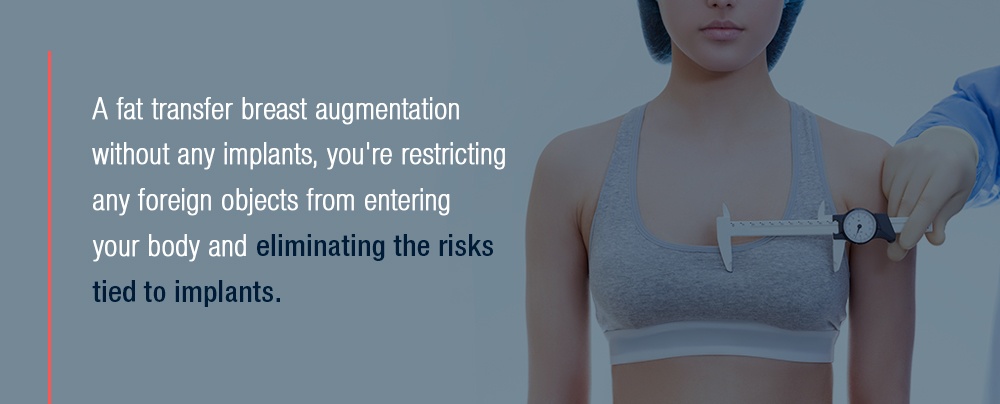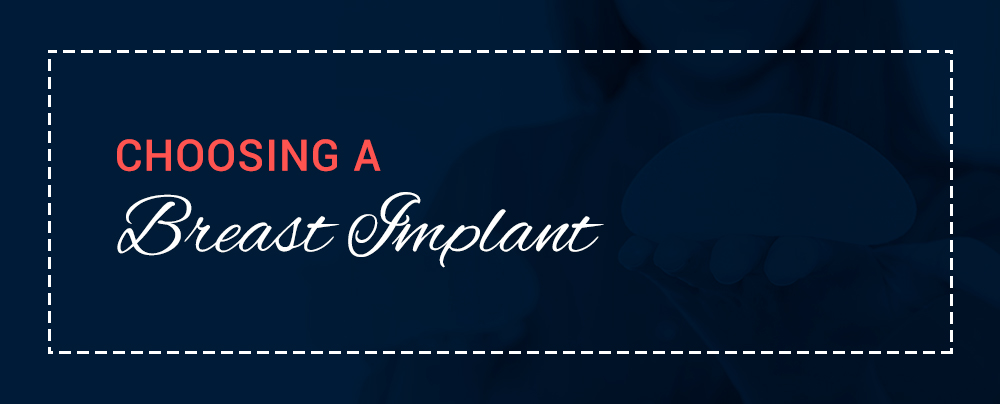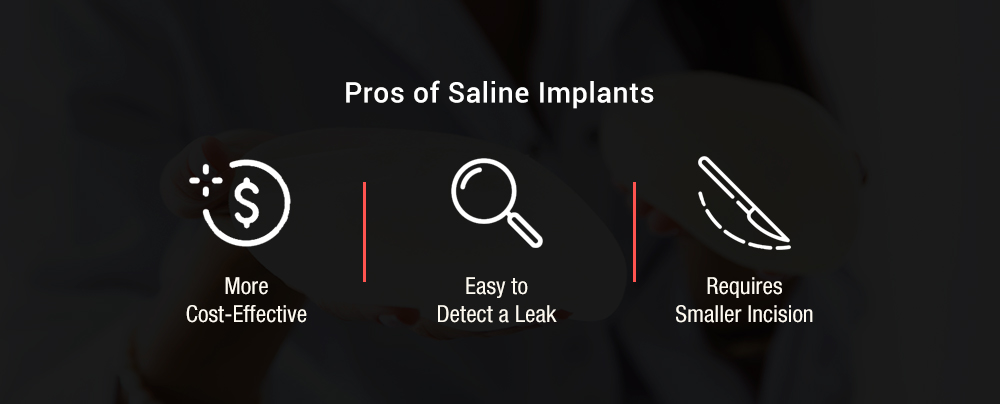Choosing a Breast Implant: Saline, Silicone or Fat Transfer?
Breast implants can help women feel more comfortable and confident with their bodies, so it’s no wonder this procedure continues to be on the rise. Currently, there are about 3.5 million people in the U.S. with breast implants. From 2000 to 2018, breast augmentations jumped 48%, and the number of procedures increased by more than 100,000, according to the American Society of Plastic Surgeons (ASPS). Doctors performed 313,735 breast augmentations in 2018 alone. Whether you want something a little larger to help balance out your body or are seeking implants to help camouflage a previous condition, they are an excellent way to boost self-esteem. The U.S. Food and Drug Administration approved two main implant options for breast augmentation — saline and silicone.
Pros and Cons of Saline Implants
Saline breast implants are filled with a sterile saltwater solution and have a silicone shell around the outside of the implant. Doctors typically put these implants in empty and then will insert the saltwater solution during surgery. However, saline implants may also come pre-filled. Women may get saline implants for breast augmentation starting at 18 years old. They are very uniform in shape, feel, and firmness once inserted and come in a variety of sizes.
Saline implants are also available with textured shells or smooth shells, but most augmentations use smooth shells that complement the implant’s inner structure to allow for a more natural feel. You may also find these implants used in revision surgeries to correct anything from the first surgery. Do you think saline implants could be right for you? Factor in the following pros and cons if you’re considering saline implants for your breast augmentation.
Pros
Saline implants could be an excellent option for your breast augmentation if the cost is a concern, as they’re generally lower cost than silicone. Additionally, it’s easy to tell if your implant is leaking with saline, and you usually are left with a smaller scar than with silicone implants.
1. More Cost-Effective
According to the American Society of Plastic Surgeons, the average cost of breast augmentation surgery is just over $3,800. While you don’t want to sacrifice quality when it comes to a surgical procedure, you’re still likely mindful of cost. In both breast augmentation and breast reconstruction surgery, saline implants are almost always more affordable than silicone.
2. Easy to Detect a Leak
With any breast implant, it may eventually rupture. Whether your implant breaks from a traumatic event or after many years in the body, the ideal thing about saline implants is that you’ll typically notice if it happens. When a saline implant ruptures, the breast will quickly lose its shape as the saline solution leaks out. However, saline ruptures are generally painless, and your body can absorb the saltwater solution. The sooner you notice a leak, the easier it is to correct.
3. Requires Smaller Incision
When doctors perform breast augmentations using saline implants, they can make smaller incisions, so patients leave with less scarring. The most commonly used incision in breast augmentations in the U.S. is the inframammary incision. It has been found that doctors can make this incision significantly smaller when inserting saline implants.
Cons
Everything has some downsides, but don’t let these stand in the way of making a decision one way or another. Two of the biggest concerns when it comes to saline implants are the look and feel when it comes to mimicking your natural breasts. Consider these cons to saline implants to help you make a well-informed decision so you can be happy with your results.
1. Doesn’t Feel as Natural
Although no implants will feel exactly like your natural breasts, some people have a natural feel as their top priority when it comes to implants. Some women feel as if saline implants aren’t as natural-feeling as silicone implants, as the silicone gel tends to mimic the feel of natural breasts better. Plus, some women may experience the saline solution sloshing around on occasion.
2. More Prone to Visible Rippling
For many women, the appearance of breast implants is just as important as how they feel. Sometimes breast implants fold or wrinkle, resulting in rippling. While rippling is common among breast implants, visible rippling or wrinkling is not. Sometimes saline implants can create visible ripples if they are underfilled or overfilled. Additionally, If you have thinner skin around the breast area, the rippling of your saline implants tends to be more visible. Overall, there is typically more visible rippling when it comes to saline implants versus silicone.
Pros and Cons of Silicone Implants
In silicone breast implants, the outer shell is filled with a silicone gel instead of a saltwater solution, like in saline implants. The gel found in silicone implants is sticky and thick, resembling the feeling of human fat. These implants also come in a variety of sizes and are available with both textured and smooth shells. Like saline implants, doctors also use silicone implants in revision surgeries. However, women who wish to get silicone implants for breast augmentation must be at least 22 years old.
Silicone is the more popular breast implant option, as 88% of all breast augmentations performed in 2018 used silicone implants, according to the ASPS. If you think silicone implants may be the better option for your breast augmentation, consider the following pros and cons to help you reach your decision.
Pros
Many women praise silicone implants for their ability to capture both the feel and look of natural breasts. If you’re seeking an implant closest to the real thing, you might opt for silicone. Additionally, silicone implants won’t completely collapse from a leak as saline implants would. If you’re already leaning toward silicone inserts, here are some reasons you’ll likely stick with them.
1. Mimics Feel of Natural Breasts
Since the silicone gel in the implants has a viscous consistency of human fat, they mimic real breasts in a way the saline solution struggles to. This may be more comfortable inside your body as it feels more similar to your natural breast tissue.
2. Less Prone to Visible Rippling
Again, all implants could potentially ripple, but it is much more uncommon for silicone implants to show visible signs of wrinkling or rippling. Plus, newer silicone inserts like gummy bear implants have a firmer gel that still resembles the feeling of natural breasts while cutting down on rippling. These gummy bear inserts also have a teardrop shape that helps maintain a natural look, so you can get the profile you’re seeking.
3. Won’t Collapse From a Leak
Unlike saline implants that immediately start breaking down when they rupture, silicone implants maintain their shape through leaks. If something were to happen that would cause your silicone implants to leak, you could continue without compromising your appearance. However, you should still visit your plastic surgeon immediately if you think your implant may be ruptured.
Cons
While you may gravitate toward silicone implants, it’s still essential to consider the less-desirable factors of these implants that could impact your decision-making process. Although these implants may feel and look more natural, they come at a higher cost. Plus, maintaining their shape through a rupture is convenient, but also makes it extremely challenging to detect a leak in the first place.
1. More Expensive
While quality comes at a cost, it’s up to you to determine what price is too much. On average, silicone gel implants run about $1,000 more than saline implants. This isn’t including any MRI scans or follow-up visits often recommended with silicone breast implants to look for things like undetected leaking. If you’re very mindful of price, this could be a major deciding factor.
2. Leaking Could Go Undetected
Like saline implants, it’s not uncommon for silicone implants to eventually rupture with age or by trauma. However, when silicone implants leak, you likely won’t notice. Silicone implants are prone to silent ruptures, which are often undetectable by physical examination only. While some instances of rupture may result in things such as lumps, an uneven appearance, pain, burning, swelling, or decreased size, other times, it’s much more challenging to tell. When the implant ruptures, the gel can either stay around the implant within the scar tissue or escape into other parts of the body and become difficult to remove.
How Fat Transfer With Breast Implants Works
Another method more women are finding successful is fat transfer breast augmentation. This process uses excess fat from other areas of your body to enhance your breast size, contour, and shape without using any implants. The fat transfer can come from essentially anywhere you have unwanted fat. This transfer process is also known as fat grafting, and you can use it in addition to breast implants for extra enhancement and customization. It’s also a popular method used in breast reconstruction.
To start, the doctor makes the autologous fat transfer by using liposuction to take fat from other areas of your body, like the hips, abdomen, or thighs, for example. The doctor then thoroughly cleans the fat after removing it to prepare it to be used in the breasts. They will then take the fat and inject it into the breast, creating a plumping effect for a fuller, more shapely breast.
Benefits of Using Fat Transfer With a Breast Augmentation
Why use a fat transfer with your breast augmentation? There are many benefits of fat grafting for breast augmentation. For one, this process reduces your unwanted fat from other areas on the body. So, your breasts benefit, and so do the other parts on your body that now hold less fat. If you choose to undergo a fat transfer breast augmentation without any implants, you’re also restricting any foreign objects from entering your body and eliminating the risks tied to implants. However, don’t forget you can use the fat transfer process in addition to implants.
Additionally, fat transfer may have a shorter recovery time, as many patients can go back to work after a week or so. This process is also minimally invasive, as the doctor isn’t making any large incisions. While you may suffer from noticeable implant scarring, fat transfer hardly ever leaves you with any significant visible scars. Lastly, fat transfer is an excellent method to customize and reshape your breasts in a way that the doctor couldn’t otherwise with implants.

Downside of Using Fat Transfer With a Breast Augmentation
While utilizing autologous fat without the need for a foreign body implant sounds appealing to most, it currently is not a commonly used technique for primary breast augmentation. It is most often used as an adjunct technique in breast reconstruction or augmentation to help fine-tune size and shape to maximize the cosmetic outcome. This is because fat grafting continues to be somewhat unpredictable in estimating the final results. A significant percentage of fat that is transferred may not “take” and the desired breast size may not be achieved with one procedure. This could also lead to asymmetry in comparison to the opposite breast depending on how much of the fat survives on the contralateral side. In addition, some of the fat that is transferred may not survive and may become fat necrosis nodules or cystic structures which often present as palpable lumps on an exam. These may need further evaluation in the form of radiology studies or even biopsy to rule out concerning lesions such as breast cancer. For these reasons, fat grafting is currently most often used as a complementary technique for obtaining desired breast size and shape.
What to Consider Before the Procedure
With any surgical procedure, it’s critical to take the necessary steps you need to prepare. This includes spending time thinking about things such as your health and long term goals, for example. Are you healthy? Do you smoke? Are you trying for a baby? These are all things you must consider as you prepare for the breast augmentation procedure.
Before your procedure, your doctor should give you specific pre-operative instructions so you can be ready for surgery. If you’re an avid smoker, keep in mind that you must quit at least four weeks before your surgery. You must also avoid any aspirins or other medicines that can thin your blood for at least ten days before your breast augmentation. You should not drink any alcohol within 24 hours or eat or drink anything for at least eight hours beforehand. You should also postpone surgery if you’re pregnant or planning to become pregnant, as breast augmentation can have adverse effects on pregnancy and breastfeeding.
On the day of your procedure, make sure you have someone to pick you up and stay with you since you are restricted from driving and cannot be alone for the first day of your procedure. Take off any nail polish, makeup, contacts, and accessories before you go into surgery as well. You should also arrange anything you may need for the days following your surgery since you need to spend time relaxing and recovering.
Schedule Your Breast Augmentation With Dr. Brought at SPRSI Today
If you’re unhappy with the way your breasts look or have a preexisting condition you want to be corrected, reclaim your confidence and schedule your breast procedure consultation with Dr. Brought and his team at Southern Plastic and Reconstructive Surgical Institute. Dr. Brought is a board-certified plastic surgeon with extensive experience in cosmetic surgery, so he and his staff can meet with you to find a personalized solution that provides the results you want. Whether you’re looking for saline or silicone implants, fat grafting, or a combination of the two, Dr. Brought has the expertise to help you with your breast augmentation, just like he’s helped numerous patients in the Nashville area. Contact us today and be on your way to beautiful, balanced breasts so you can look and feel your very best.



